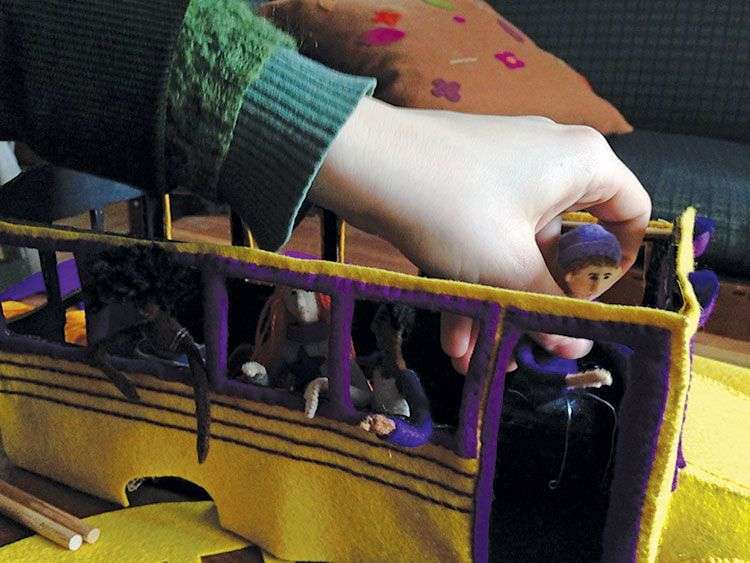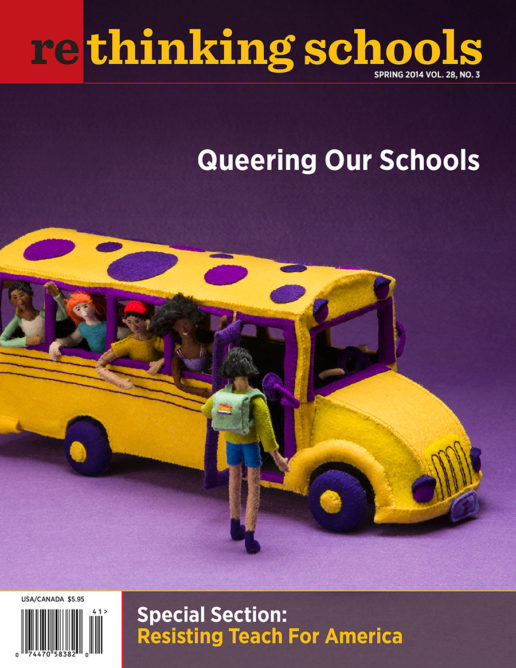Editorial: Queering Schools
Illustrator: James Gill

On Nov. 5, Illinois became the 16th state to legalize same-sex marriage. And Sasha Fleischman’s skirt was set on fire on an Oakland, California, bus by a 16-year-old student from another school (Sasha is an agender youth1). What a contradiction. And what a clear example of the complex state of LGBTQ issues at this moment in history. What does this contradiction mean for students, teachers, and schools?
One reason the tragedy in Oakland is significant is because of what happened after Sasha was seriously burned and the Oakland High junior who set the fire was charged as an adult with two felony hate crimes. Students and teachers at Oakland High responded by mobilizing support for Sasha. They collected money for medical expenses and sponsored a “Stroll for Sasha” along the bus route, which was spontaneously marked by rainbow ribbons. The varsity basketball team wore “No H8” T-shirts with Sasha’s name on the back.
Meanwhile, Sasha and Sasha’s family stressed education rather than law and order, urging that the accused student be tried as a child, not an adult. Sasha’s dad, Karl, who is a teacher at Sequoia Elementary School, focused on how to talk with students. In a letter to the Sequoia community, he said:
None of us can know the mind of the kid who lit a flame to Sasha’s skirt. But I have a feeling that if he had seen Sasha’s skirt as an expression of another kid’s unique, beautiful self, and had smiled and thought “I hella love Oakland,” I wouldn’t be writing this now.
And that’s the question, isn’t it? How do we create classrooms and schools where each child, parent, and staff member’s unique, beautiful self is appreciated and nurtured? The terrain, in terms of legal rights and public conversation, is shifting rapidly, creating space for enormous advances in curriculum and school climate. At the same time, homophobia, misogyny, and other forms of hatred are alive and well, and even progressive schools and classrooms have a long way to go in creating nurturing spaces for students, parents, and staff who don’t conform to gender and/or sexuality “norms.” So how do we move forward?
Build Community
Despite the recent advances in LGBTQ rights, most schools aren’t safe for queer students. In a recent survey, six out of 10 LGBTQ teens said they felt unsafe at school and 82 percent had been verbally harassed because of their sexual orientation. In response to a series of high-publicity tragedies, 49 states have passed “anti-bullying” legislation. That’s a good first step. But there are serious problems with focusing on bullying rather than social justice.
Talking about “bullies” makes it seem like an individual problem and glosses over homophobia, sexism, racism, Islamophobia—all the critical issues that underlie conflicts among children and adults. As Lyn Mikel Brown explained (“10 Ways to Move Beyond Bully Prevention and Why We Should,” spring 2009):
To lump disparate behaviors under the generic “bullying” is to efface real differences that affect young people’s lives. Bullying is a broad term that de-genders, de-races, de-everythings school safety.
There are reasons why teachers and administrators are reluctant to adopt schoolwide approaches that open up discussions of LGBTQ rights and homophobia. We worry about backlash from parents. As the movement has developed past its early “gay liberation” beginnings, it has become more complex; teachers who felt comfortable talking about lesbians and gay men need to wrap their hearts and minds around transgender issues and challenges to the socially constructed gender binary. And when you invite kids to talk openly and ask questions about gender and sexuality, you have to be ready for whatever happens. It’s trickier than geometry.
But it’s also a critical key to building community where no one is silenced, where everyone’s reality is recognized and valued. And it’s definitely possible. As Karl Fleischman explained in his letter:
Being agender simply means that the person doesn’t feel they are “either a boy or a girl.” I realize this is a concept that even adults have difficulty wrapping their heads around . . . so I can’t pretend that it’s an issue that all young children will grasp. But what they certainly can and should understand is that different people like different things. Different people dress or behave or look differently. And that’s a GOOD thing.
The cornerstone of nurturing classrooms and schools is community, where everyone talks out problems, gets to know each other, and feels that they are part of something larger than themselves. Part of this is emphasizing empathy, which is at the heart of both solidarity and social justice teaching, and thus at the heart of creating safe spaces for everyone. This means a school filled with adults who are prepared to talk and listen to children talk about gender and sexuality, as well as other controversial and sensitive topics—adults who are willing to learn from youth as well as lead them. Community is built by working through differences, not sweeping them under the rug.
One beginning step is making sure that school structures support all families. A few examples: forms that ask for information for Parent/Family Members instead of Mother and Father; easily accessible gender-neutral bathrooms for everyone; no lining kids up in girls’ lines and boys’ lines; gym classes and locker rooms that accommodate a range of gender identities; honorary positions (for prom, homecoming, etc.) that are neutral for gender and sexual identity; diverse representation in posters, curriculum, library and classroom books, speakers, the arts, and school leadership. Equally important is empowering students to participate—at school and in the community—in organizations fighting for all kinds of social justice, including gay/straight alliances.
Safe Adults, Safe Students
A couple of years ago, several of us from around the country participated in a workshop sponsored by Educators’ Network for Social Justice in Milwaukee. The topic was teachers coming out at school. It was a good discussion, but the talk kept drifting back to making schools safe for kids. It was hard to stay focused on making schools safe for LGBTQ teachers and staff. Even talking about it felt risky.
But no number of classroom discussions about gender stereotypes and homophobia will create a nurturing environment if teachers and parents are afraid to come out. A school that’s a protective community for LGBTQ adults is a school that’s going to be safe for kids.
What might that look like? When Jody Sokolower, Rethinking Schools managing editor, came out to her 7th-grade students her first year of teaching, the principal and vice principal accused her of “talking about her sex life” and put a disciplinary letter in her file. When she called the union, her district rep immediately promised that the union would fight for her, and sent letters to that effect to the principal and to Jody’s file. That backing was enormously important, both emotionally and practically. Union support is critical.
So is educating and uniting teachers and staff. And mobilizing parents. At many elementary schools, parents have joined together to form LGBTQ parent committees that go into classes to lead workshops and advise teachers. If some parents in the school are worried about LGBTQ content, PTA discussions can be invaluable. It’s Elementary, a documentary with age-appropriate teaching about LGBTQ issues from kindergarten through middle school, is a great resource.
Queering the Curriculum
Educators and scholars of color have argued for many years that multicultural education means moving beyond “heroes and holidays” to integrating the history and lives of people of color into curriculum at every point. The same is true for LGBTQ issues and people. Participating in the Day of Silence can be a good start, but a social justice frame demands an approach to curriculum that integrates queer people – their problems, history, struggles, and contributions – into day-to-day curriculum, K-12, across the subject areas.
In elementary school, for example, does the literature read in the classroom reflect children with gay and lesbian parents, as well as a broad range of other family structures? What is the approach to activities like Father’s Day, Mother’s Day, and “family tree” assignments? (It’s worth noting that the “traditional” mom-dad-and-kids family is a minority, not a majority experience, so many children and their families are affected by what are often oppressive school customs).
Adam Kelley’s article on teaching the school-to-prison pipeline to high school students is an example of the process of queering a piece of curriculum. “Transsexuals, Teaching Your Children” (spring 2010), which looks at queering curriculum in a middle school classroom, includes a great resource: From the Notebooks of Melanin Sun, by Jacqueline Woodson. What about enlarging a study of the Harlem Renaissance to explore the lives and impact of such LGBTQ poets, authors, and musicians as Langston Hughes, Countee Cullen, Angelina Weld Grimk, Ethel Waters, Gertrude “Ma” Rainey, Bessie Smith, and Josephine Baker? What about including the Lavender Scare in the study of the McCarthy era? Or the Stonewall Riots as part of the political foment of the late ’60s? Or considering implications of the campaign for LGBTQ acceptance in the military in the context of questioning current U.S. military strategy?
None of this is easy. But every step leads to the next one. A friend of ours was recently mentoring a preservice teacher whose students were changing singular verbs to plural. One student looked at the example in the book: “My mom is swimming.” After hesitating for a minute, the student pulled out a solution: “My parents are swimming.” The teacher moved on to the next child. Later, the mentor suggested gently, “You know, that was an opportunity to mention the fact that some kids have two moms, and that it would be fine to say, “My moms are swimming.”
Looking Forward
Meanwhile, Sasha was home for Thanksgiving and back at school shortly thereafter, using media interest in the case as an opportunity to explain different aspects of nonbinary gender identity. Sasha told reporters they probably won’t ride the bus alone for a while, but concluded the interview: “I’m going to keep wearing a skirt. It’s a big part of who I am.”
Sharing current stories of history-making activists like Sasha – or Jeydon Loredo, a transgender student who successfully sued his school district to have his senior picture included in his high school yearbook; Destin Holmes, a lesbian student standing up to abusive treatment by teachers and her principal; or the student body of Waukegan High School, which elected a gay and lesbian duo as their king and queen – can inspire dialogue and understanding as we work to help schools catch up in the march toward justice.
Footnotes
- People who are agender don’t identify as female or male. They see themselves as outside the gender binary.

